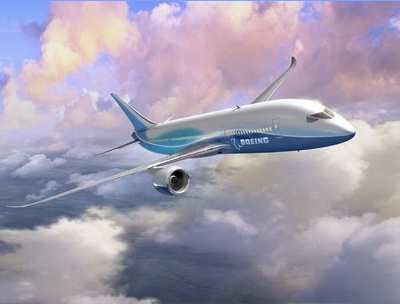Tue, May 06, 2003
Concept Design Pushes Boeing Engineers to Consider Innovative
Approaches
 Boeing has released a new image of its
super-efficient 7E7 commercial airplane. Engineers are using this
7E7 concept to push their thinking to more innovative exterior
designs for the new airplane. The new image shows a distinctive
nose shape, new wing tip concepts and a sculpted vertical tail
structure.
Boeing has released a new image of its
super-efficient 7E7 commercial airplane. Engineers are using this
7E7 concept to push their thinking to more innovative exterior
designs for the new airplane. The new image shows a distinctive
nose shape, new wing tip concepts and a sculpted vertical tail
structure.
“The basic shape of large commercial jet airplanes has
remained essentially unchanged since the introduction of the Boeing
707 nearly 50 years ago,” said Mike Bair, senior vice
president of the 7E7 program. “There’s a good reason
for that. The shape is optimal for achieving lift, fighting drag
and producing efficient, comfortable flight.”

Subtle touches, however, can be added to produce a more unique
shape without affecting the performance of the airplane. Engineers
are studying these touches for consideration on the new 7E7.
“We are using this concept similar to how automobile
designers use concept cars, to stretch our imaginations, to
consider new possibilities and to help us design the best possible
product for our customer,” Bair said. “The conventional
image that we have shown the world for the past four months is very
much our baseline design. But we want to go beyond baseline to
something that people will know by sight -- like the way we all
know a 747 when we see one.”
 Designers will continue to consider alternative
design features through the summer and finalize the airplane
configuration by the end of the year. “Airplane designs
change during development,” Bair said (right). “I
don’t expect the 7E7 will look exactly like either the
baseline image we’ve shown since January or this concept
image. I expect we will take the best of both to come up with
something unique that meets the needs of our customers and
satisfies the flying public.”
Designers will continue to consider alternative
design features through the summer and finalize the airplane
configuration by the end of the year. “Airplane designs
change during development,” Bair said (right). “I
don’t expect the 7E7 will look exactly like either the
baseline image we’ve shown since January or this concept
image. I expect we will take the best of both to come up with
something unique that meets the needs of our customers and
satisfies the flying public.”
The 7E7 is being developed as a 200- to 250-seat airplane that
will fly between 7,000 and 8,000 nautical miles at speeds similar
to today's fastest twin-aisle commercial airplanes – the 777
and 747. It will be the most advanced and efficient commercial
airplane in its class and will set new standards for environmental
responsibility and passenger comfort.
The market potential for a new airplane of this size is
forecasted at up to 3,000 units over the next 20 years. The company
expects to formally offer the new airplane to customers in early
2004.
More News
He Attempted To Restart The Engine Three Times. On The Third Restart Attempt, He Noticed That Flames Were Coming Out From The Right Wing Near The Fuel Cap Analysis: The pilot repor>[...]
Make Sure You NEVER Miss A New Story From Aero-News Network Do you ever feel like you never see posts from a certain person or page on Facebook or Instagram? Here’s how you c>[...]
From 2009 (YouTube Edition): Leading Air Show Performers Give Their Best Advice for Newcomers On December 6th through December 9th, the Paris Las Vegas Hotel hosted over 1,500 air >[...]
Aero Linx: NASA ASRS ASRS captures confidential reports, analyzes the resulting aviation safety data, and disseminates vital information to the aviation community. The ASRS is an i>[...]
“For our inaugural Pylon Racing Seminar in Roswell, we were thrilled to certify 60 pilots across our six closed-course pylon race classes. Not only did this year’s PRS >[...]
 NTSB Final Report: Rutan Long-EZ
NTSB Final Report: Rutan Long-EZ ANN FAQ: Turn On Post Notifications
ANN FAQ: Turn On Post Notifications Classic Aero-TV: ICAS Perspectives - Advice for New Air Show Performers
Classic Aero-TV: ICAS Perspectives - Advice for New Air Show Performers ANN's Daily Aero-Linx (06.28.25)
ANN's Daily Aero-Linx (06.28.25) Aero-News: Quote of the Day (06.28.25)
Aero-News: Quote of the Day (06.28.25)





